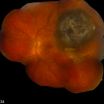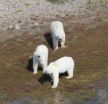Global food safety: Keeping food safe from farm to table
2010-11-05
(Press-News.org) Washington, DC – November 2, 2010 – Food safety problems can arise at any of multiple stages of food production, and illnesses that result from them are frequently not detected or reported, according to a new report from the American Academy of Microbiology.
The report, "Global Food Safety: Keeping Food Safe from Farm to Table," is based on a colloquium convened by the Academy in 2009. Colloquium participants with expertise in microbiology, public health, food science, and economics reviewed the current state of affairs in microbiological food safety around the world.
The path from food production to consumption is increasingly complicated. Each plate of food may contain ingredients from many countries—each of which may have passed through different processing facilities, and may have been handled by wholesalers, retailers, and multiple transportation companies before finally reaching the consumer's shelf or refrigerator. No single agency regulates all of the steps in this process.
Each link in the food safety chain would benefit from further research and new technologies—specific examples of which are detailed in this report. Regulations that promote good agricultural and manufacturing practices would not only help decrease lapses in food safety, but would make it easier to trace problems back to their inception.
Consumer education is also an important component of food safety. Consumers are often unaware of safe food handling practices, especially as new food products are introduced. Because consumer-caused foodborne illnesses are often not recognized as such, much less systematically reported, an important barrier to reducing their incidence is inadequate knowledge of which foods, agents, and practices pose the greatest risk.
It is very difficult to know how many people are made sick by food, which foods are at fault, which pathogens are most widespread or dangerous, and where those pathogens entered the food production system. In such a situation, where should research, prevention and education efforts be directed? In this report, each step in our complicated food production and supply system is described, highlighting key points of vulnerability and making it clear that providing safe food is a shared responsibility.
Food safety is complex, and a perfectly safe food supply is an unrealistic goal. However, as this report explains, there are opportunities for improving food safety at each step of the production and consumption process and many areas where further research could help identify and quantify risks and generate solutions. The report also identifies food safety vulnerabilities that might be addressed through investments in new technologies or more effective education.
INFORMATION:
A full copy of the report and further recommendations can be found on the Academy website at http://academy.asm.org/images/stories/documents/Global_Food_Safety.pdf.
The American Academy of Microbiology is the honorific leadership group of the American Society of Microbiology. The mission of the Academy is to recognize scientific excellence, as well as foster knowledge and understanding in the microbiological sciences. A full list of Academy colloquia reports can be found at http://academy.asm.org/colloquia. For more information about the American Society for Microbiology, contact Barbara Hyde at 202-942-9206 or visit http://www.asm.org.
ELSE PRESS RELEASES FROM THIS DATE:
2010-11-05
AUDIO:
Researchers at Washington University School of Medicine in St. Louis have identified a gene linked to the spread of melanoma of the eye. Although more research is needed, the researchers...
Click here for more information.
Researchers at Washington University School of Medicine in St. Louis have identified a gene linked to the spread of eye melanoma.
Although more research is needed, the researchers say the discovery is an important step in understanding why some ...
2010-11-05
(ST. LOUIS): Botanists at the Missouri Botanical Garden have described eight new plant species collected in the Madidi National Park and surrounding areas located on the eastern slopes of the Andes in northern Bolivia. The new species are from several different genera and families and are published in a recent edition of the Missouri Botanical Garden journal Novon.
Missouri Botanical Garden scientists and colleagues from the National Herbarium in La Paz, Bolivia describe Prestonia leco, Passiflora madidiana, Siphoneugena minima, Siphoneugena glabrata, Hydrocotyle apolobambensis, ...
2010-11-05
As the Arctic warms, a new cache of resources—snow goose eggs—may help sustain the polar bear population for the foreseeable future. In a new study published in an early online edition of Oikos, researchers affiliated with the Museum show that even large numbers of hungry bears repeatedly raiding nests over many years would have a difficult time eliminating all of the geese because of a mismatch in the timing of bear arrival on shore and goose egg incubation.
"There have been statements in popular literature indicating that polar bears can extirpate snow geese quickly ...
2010-11-05
Which are the best pieces of pork, what their texture is, how moist they are – the secrets pigs keep from even the most skilled butchers – are about to be revealed, thanks to a sophisticated new technique that has been developed by McGill University researchers in conjunction with Agriculture Canada and the pork industry. "This is about giving industry workers better tools to do their job," explained Dr. Michael Ngadi of McGill's Department of Bioresource Engineering. "Computer-aided analysis of meat will result in higher-quality jobs, optimal production, and exports that ...
2010-11-05
It's commonly accepted that we appreciate something more if we have to work hard to get it, and a Johns Hopkins University study bears that out, at least when it comes to food.
The study seems to suggest that hard work can even enhance our appreciation for fare we might not favor, such as the low-fat, low calorie variety. At least in theory, this means that if we had to navigate an obstacle course to get to a plate of baby carrots, we might come to prefer those crunchy crudités over the sweet, gooey Snickers bars or Peanut M&Ms more easily accessible via the office vending ...
2010-11-05
There are disorders and conditions that entail increased itching and can be extremely troublesome for those suffering from it. The mechanisms behind itching are not well understood today. For one thing, what is it about scratching that relieves itching?
In the current study, which was performed on mice, the research team led by Professor Klas Kullander at the Department of Neuroscience examined the nerve cells that transfer heat pain. When these nerve cells had lost its capacity to signal, the mice reacted less to heat, as expected, but surprisingly they also started ...
2010-11-05
COLLEGE PARK, Md. – The University of Maryland-led EPOXI mission successfully flew by comet Hartley 2 at 10 a.m. EDT today, and the spacecraft has begun returning images. Hartley 2 is the fifth comet nucleus visited by any spacecraft and the second one visited by the Deep Impact spacecraft.
Scientists and mission controllers are studying never-before-seen images of Hartley 2 appearing on their computer terminal screens. See images at: http://epoxi.umd.edu/
"We are all holding our breath to see what discoveries await us in the observations near closest approach," said ...
2010-11-05
Quebec City, November 4, 2010—A team of Université Laval and Danisco researchers has just unlocked the secret of bacteria's immune system. The details of the discovery, which may eventually make it possible to prevent certain bacteria from developing resistance to antibiotics, are presented in today's issue of the scientific journal Nature.
The team led by Professor Sylvain Moineau of Université Laval's Department of Biochemistry, Microbiology, and Bioinformatics showed that this mechanism, called CRISPR/Cas, works by selecting foreign DNA segments and inserting them ...
2010-11-05
Can you forge an emotional bond with a brand so strong that, if forced to buy a competitor's product, you suffer separation anxiety? According to a new study from the USC Marshall School of Business, the answer is yes. In fact, that bond can be strong enough that consumers are willing to sacrifice time, money, energy and reputation to maintain their attachment to that brand.
"Brand Attachment and Brand Attitude Strength: Conceptual and Empirical Differentiation of Two Critical Brand Equity Drivers," a study published in the November issue of the Journal of Marketing, ...
2010-11-05
Menlo Park, Calif.—Calcium regulates many critical processes within the body, including muscle contraction, the heartbeat, and the release of hormones. But too much calcium can be a bad thing. In excess, it can lead to a host of diseases, such as severe muscle weakness, a fatal reaction to anesthesia or sudden cardiac death.
Now, using intense X-rays from the Stanford Synchrotron Radiation Lightsource (SSRL) at the Department of Energy's SLAC National Accelerator Laboratory, researchers have determined the detailed structure of a key part of the ryanodine receptor, a ...
LAST 30 PRESS RELEASES:
[Press-News.org] Global food safety: Keeping food safe from farm to table




